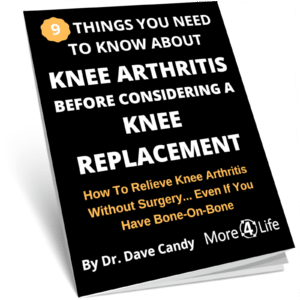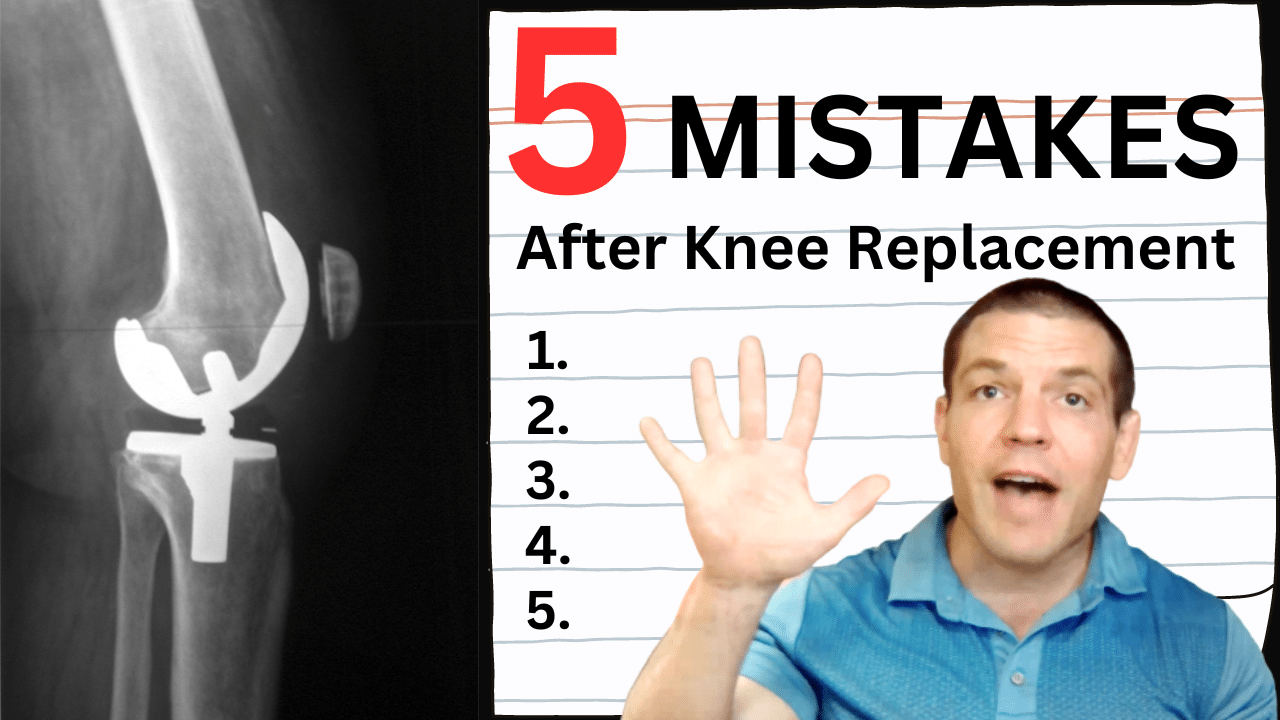Having a knee replacement is a BIG decision. After all, you're having a part of your body cut out and having metal put in it's place.
So if you're going to do it, you want to do it right.
Overall, knee replacement surgery is pretty successful, but around 20% of patients still have persistent pain following knee replacement. Since knee pain is the biggest reason why people choose to have knee replacement in the first place, failure to relieve pain in 1 out of 5 surgeries seems rather high.
Watch this video to learn the top 5 mistakes after knee replacement that people make so that you can avoid them.

What Are The Top 5 Mistakes After Knee Replacement?
- Not Having the Right Mindset Going into Surgery
- Poor Post-operative Pain Control
- Failing To Achieve Full Knee Extension
- Neglecting or Skipping Physical Therapy
- Pushing Too Hard After Knee Replacement
Mistake #1: Not Having the Right Mindset Going Into Knee Replacement Surgery
Hopefully you're reading this post before knee replacement surgery because the #1 top mistake after knee replacement actually starts before surgery.
That mistake is not having the right mindset going into surgery.
You may think that sounds new-age, alternative, or hocus pocus.
But clinical research actually backs it up.
The top predictors of persistent pain following total knee replacement replacement across multiple studies ranging from 3-96 months after surgery were:
- Pain catastrophizing
- Mental health (i.e. anxiety, depression)
- Preoperative pain levels
- Pain in other areas besides the knee
This makes sense when you consider the biopsychosocial model of knee arthritis pain.
The Biopsychosocial Model of Knee Arthritis Pain
The first two predictors have to do with the psychosocial domain while the second two have to do more with nervous system sensitivity.
Degree of knee arthritis, range of motion measurements, age, gender, bodyweight, and other factors that you might expect to be associated with outcome actually AREN'T according to the research.
And that's not just one study. The article referenced was a meta-analysis of MULTIPLE studies on the topic.
So really, the BEST thing that you can do is get your mind in the right place and decrease your pain before knee replacement surgery.
If you're going to have a knee replacement, fully commit to it.
BELIEVE you're going to get better and don't second guess you decision once you've made it.
When you're having a part of your body removed, that's a BIG decision, so have to be either all in, or all out.
If you're not certain about your decision to have a knee replacement surgery, it's best to wait until you ARE sure.
Once you've committed mentally, don't listen to nay-sayers.
Temporarily distance yourself from family or friends who tell you about the horrible result that someone they know had after a knee replacement.
Only surround yourself with people who support your decision.
That includes your family, your surgeon, and your physical therapist.
Additionally, controlling your pain BEFORE your knee replacement helps decrease how sensitive your nervous system is after surgery.
Your nervous system is like an alarm system warning you of danger.
When someone cuts into your skin with a scalpel and then saws off your knee with a bone saw, and hammers a railroad spike into your leg, that DEFINITELY qualifies as danger.
It WILL hurt after surgery, but the less sensitive your alarm system is before surgery, the LESS it will hurt.
Which brings me to top mistake #2...
Mistake #2: Poor Post-operative Pain Control After Knee Replacement
When you have a knee replacement, you sustain considerable tissue damage.
It's for a good reason, but with knee replacement surgery, you're CAUSING a new injury to fix an old one.
The GOOD news is that you're trading an acute injury for a chronic one.
And acute injuries are better at healing than chronic ones.
But your nerves (a.k.a your alarm system) is going to ring LOUDLY because you've just encountered what it perceive a dangerous situation.
Therefore, your brain is going to tell you do take protective actions such as NOT moving to prevent future injury.
But you NEED to move after knee replacement surgery.
Movement helps you decrease swelling in the acute phase. Plus, you'll get your muscles re-activated and regain your range of motion.
So TAKE YOUR PAIN MEDICATION!
It will allow you to do the exercises you need to do to regain your range of motion.
And if you don't regain range of motion quickly after surgery, it gets much harder to regain down the road.
That's especially true for straightening your knee (knee extension).
Mistake #3: Failing To Achieve Full Knee Extension
After knee replacement surgery, you're going to have swelling in your knee and have post operative dressings.
That's going to limit your knee range of motion initially.
But as your post operative bleeding and swelling heals, you can develop adhesions in your muscle fibers as well as in the knee joint itself.
Once that happens, it becomes very hard to regain full knee motion.
The best way to prevent this from happening is getting EARLY motion after surgery.
Improvements in knee bending (flexion) will come rather quickly and its encouraging to see the numbers go up. You may start at 60 degrees or less initially up to 90 degrees, and eventually up to 120 degrees or more.
However, your knee will likely only start around 20 degrees or so away from being fully straight.
So it's not quite as rewarding to see such small improvements in knee extension vs. larger improvements in knee flexion.
Therefore, it's easy to neglect.
In addition to that, since you're usually doing your exercises in bed initially, your knee may look straight when it's on the mattress when it's actually not.
So focus on getting your knee straight as soon as possible.
The bending will come with time, but knee straightening is time-critical.
Additionally knee straightening exercises such as quad sets help you activate your quadriceps muscles.
Having full knee extension and fully functioning quads help make your knee stronger and reduce the risk of your knee buckling when walking.
Mistake #4: Neglecting Or Skipping Physical Therapy
Once you've gotten full knee extension, you've still got a long way to go.
Having a knee replacement isn't like driving your car into the shop to have a new set of tires put on.
You've likely got at least a few months of physical therapy ahead of you.
Even if your pain gets better soon after surgery, you still need to regain your range of motion and strength so that you can stand up from sitting, walk without a limp, go up and down stairs, and get up from the floor.
Remember, just because you have a total knee joint replacement doesn't mean that you have a totally new knee.
You still have the same muscles that were there before the surgery, and there was likely some muscle imbalance that caused the cartilage loss in your knee in the first place.
That might be muscle stiffness in the:
That might be weak hip muscles.
In any case, skipping or neglecting your physical therapy is definitely a top mistake after knee replacement.
Many people who HAVE had bad results after knee replacement will openly admit, "I didn't do my physical therapy like I should have."
Conversely, people who have good outcomes will often say, "You've got to do the physical therapy."
Again, if you're going to have knee replacement, you've got to be ALL IN or ALL OUT.
Mistake #5: Pushing Too Hard, Too Fast After Knee Replacement
You have to do your physical therapy, and you WILL have pain during the process.
But you shouldn't push yourself to the point of horrible pain.... nor should your physical therapist.
The days of stretching to the maximum and pushing through pain are past.
It's actually counter-productive, especially after a surgery like a knee replacement.
Remember that your nerves are going to be sensitive, and your alarm system is going to be ringing loudly after surgery.
If you teach your brain that movement = pain, that further sensitizes your nerves.
That actually increases pain and makes your nerves more irritable.
You need to exercise in the "sore but safe" range where you may have a little discomfort during the exercise, but you should either feel better (or at least no worse) AFTER exercise.
Furthermore, if you stretch your muscles to the point of pain, they actually spasm as a protective response.
When a muscle spasms (contracts), it attempts to shorten.
If you're shortening your muscles at the same time you're trying to stretch (lengthen) them, it just doesn't work.
You will have some pain when exercising after a knee replacement, but don't make the mistake of pushing to the point of horrible pain.
Want To Avoid Mistakes After Knee Replacement?
It's a good idea to meet with both your doctor and your physical therapists BEFORE surgery and make sure you're all on the same page as to your post-operative plan.
Additionally, the book Your Nerves Are Having a Knee Replacement by Adriaan Louw, one of the leading pain researchers in the world, gives some easy-to-digest information to help you prepare for your knee surgery.
Your Nerves Are Having a Knee Replacemen...
$7.95 (as of May 2, 2024 10:41 GMT -05:00 - More infoProduct prices and availability are accurate as of the date/time indicated and are subject to change. Any price and availability information displayed on [relevant Amazon Site(s), as applicable] at the time of purchase will apply to the purchase of this product.)It's more of a pamphlet, not a novel, but the information is good.
Additionally, you can download our FREE guide 9 Things You Need To Know Before Considering A Knee Replacement to give you some more tips to help you avoid some top mistakes after knee replacement.
Additionally, if you live in the St. Louis, MO area and need help BEFORE or AFTER a knee replacement, tap the button below to request an appointment with one of our specialist physical therapists.




